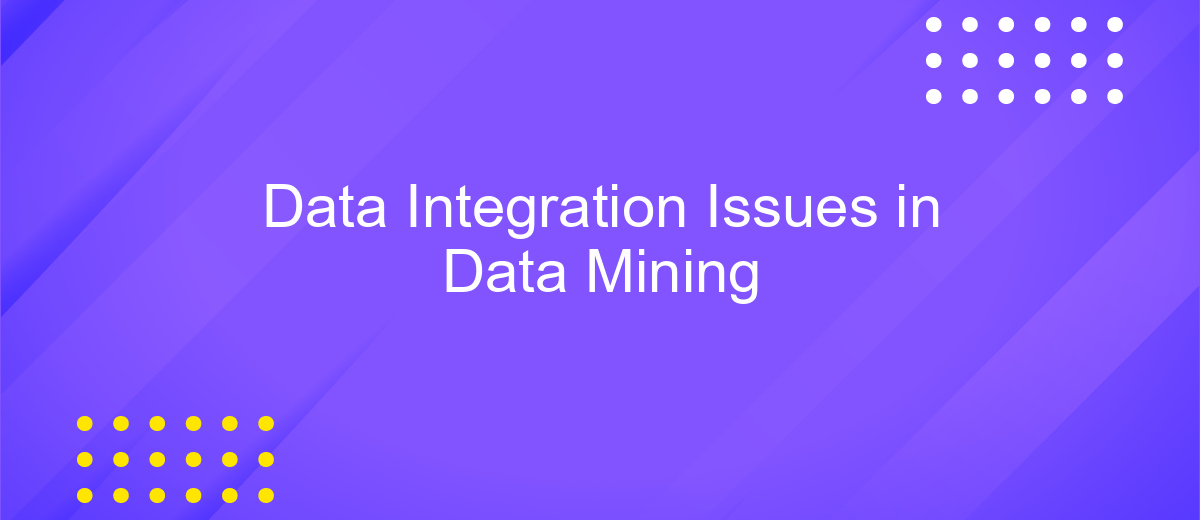Data Integration Issues in Data Mining
Data integration is a critical step in the data mining process, involving the combination of data from various sources to provide a unified view. However, this process is fraught with challenges such as data inconsistency, redundancy, and differing data formats. Addressing these issues is essential for accurate analysis and meaningful insights, making data integration a pivotal aspect of successful data mining projects.
Introduction
Data integration is a critical step in the data mining process, as it involves combining data from various sources into a coherent dataset. This integration is essential for ensuring the accuracy and completeness of the data, which in turn impacts the quality of the insights derived from data mining. However, data integration is fraught with numerous challenges that can hinder the effectiveness of data mining efforts.
- Data heterogeneity: Different data sources often have varying formats and structures, making it difficult to integrate them seamlessly.
- Data redundancy: Overlapping information from multiple sources can lead to redundant data, complicating the integration process.
- Data inconsistency: Inconsistent data values across sources can result in inaccurate analysis and misleading conclusions.
- Scalability issues: As the volume of data grows, integrating large datasets efficiently becomes increasingly challenging.
Addressing these issues requires robust data integration techniques and tools that can handle the complexities of modern data environments. By overcoming these challenges, organizations can unlock the full potential of their data, leading to more informed decision-making and enhanced business outcomes.
Data Integration Challenges

Data integration in data mining presents numerous challenges, primarily due to the heterogeneity of data sources. These sources often use different formats, structures, and schemas, making it difficult to combine them into a unified dataset. Additionally, data quality issues such as missing values, duplicates, and inconsistencies can further complicate the integration process. Ensuring data accuracy and consistency across various sources is crucial for reliable data mining outcomes, yet it remains a significant hurdle for many organizations.
Another challenge is the scalability of data integration solutions. As the volume of data continues to grow, integrating large datasets efficiently becomes increasingly complex. Tools and services like ApiX-Drive can help mitigate some of these challenges by automating the integration process and providing a user-friendly interface for managing data flows. ApiX-Drive supports various data sources and formats, allowing for seamless integration and reducing the manual effort required. However, even with such tools, ongoing maintenance and monitoring are essential to address any emerging issues and ensure the continuous accuracy and reliability of the integrated data.
Data Integration Techniques

Data integration is a critical step in data mining, as it combines data from multiple sources to provide a unified view. Effective data integration ensures that the data is accurate, consistent, and ready for analysis. Various techniques are employed to achieve seamless data integration, each with its own advantages and challenges.
- Schema Integration: This technique involves merging schemas from different data sources into a single, coherent schema. It addresses issues like naming conflicts and data type discrepancies.
- Data Cleaning: This process identifies and corrects errors and inconsistencies in the data. It includes tasks such as handling missing values, removing duplicates, and standardizing formats.
- ETL (Extract, Transform, Load): ETL tools extract data from various sources, transform it into a suitable format, and load it into a target database or data warehouse. This method is widely used for its robustness and scalability.
- Data Federation: This approach allows querying across multiple, heterogeneous data sources without physically consolidating the data. It provides a virtual integration layer for real-time data access.
Choosing the right data integration technique depends on the specific requirements and constraints of the data mining project. By carefully selecting and implementing these techniques, organizations can ensure high-quality, integrated data that supports effective decision-making and insights.
Case Studies and Examples

Data integration in data mining is often fraught with challenges, as demonstrated by several case studies. One notable example is a multinational retail corporation that struggled to consolidate customer data from various regional databases, leading to inconsistencies and incomplete profiles.
Another case involves a healthcare provider aiming to integrate patient records from multiple sources, including electronic health records (EHRs), lab results, and insurance claims. The discrepancies in data formats and standards posed significant hurdles, impacting the quality of patient care.
- A financial institution faced difficulties merging transaction data from different banking systems, resulting in delayed fraud detection.
- An e-commerce company encountered issues in integrating product data from various suppliers, affecting inventory management.
- A government agency struggled to combine census data from different years, leading to inaccurate population statistics.
These examples underscore the importance of addressing data integration issues proactively. Effective strategies, such as adopting standardized data formats and employing advanced data integration tools, are essential for ensuring the accuracy and completeness of integrated datasets.


Conclusion
In conclusion, data integration remains a critical challenge in the realm of data mining, as it involves combining data from diverse sources to provide a unified view. The complexity of dealing with heterogeneous data formats, inconsistent data, and varying data quality can significantly hinder the efficiency and accuracy of data mining processes. Effective data integration strategies are essential to ensure that the data is clean, consistent, and ready for analysis.
Tools like ApiX-Drive play a pivotal role in simplifying the data integration process by automating the connection between various data sources and applications. By leveraging such services, organizations can reduce the manual effort involved in data integration, minimize errors, and improve overall data quality. As technology continues to evolve, the adoption of robust data integration solutions will be crucial for maximizing the potential of data mining and deriving actionable insights from complex datasets.
FAQ
What are the common challenges in data integration for data mining?
How can data redundancy be minimized during data integration?
What is the role of ETL (Extract, Transform, Load) in data integration?
How can automated tools help in data integration?
What steps can be taken to ensure data quality during integration?
Do you want to achieve your goals in business, career and life faster and better? Do it with ApiX-Drive – a tool that will remove a significant part of the routine from workflows and free up additional time to achieve your goals. Test the capabilities of Apix-Drive for free – see for yourself the effectiveness of the tool.

